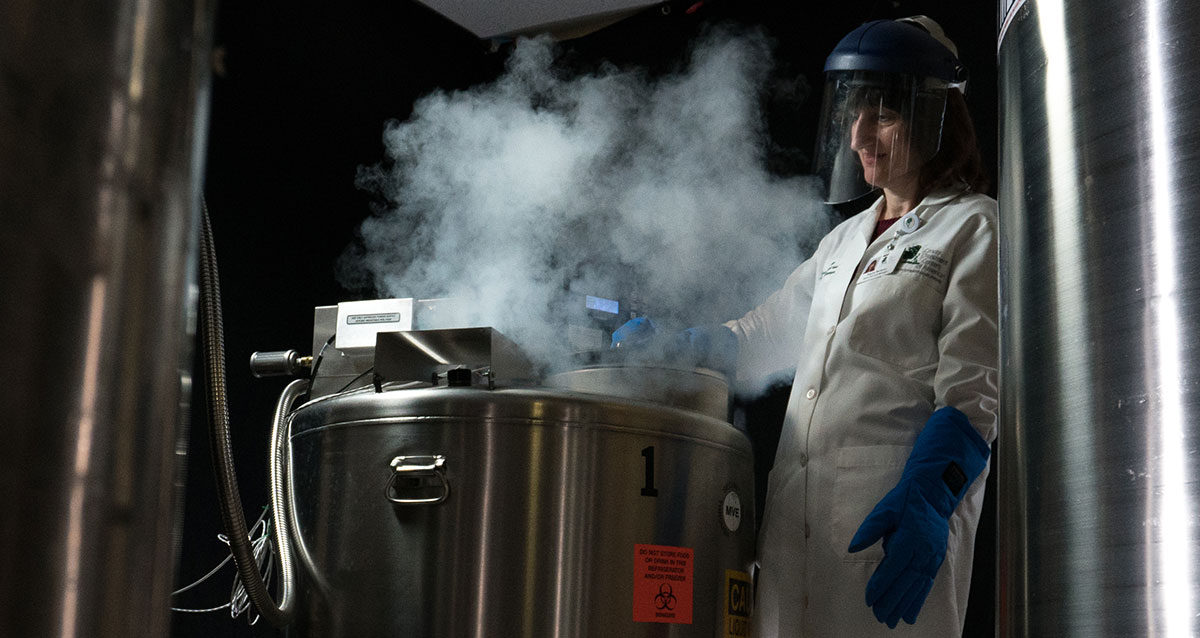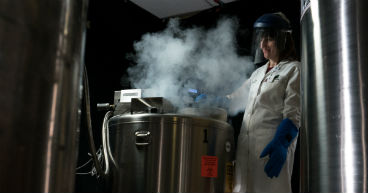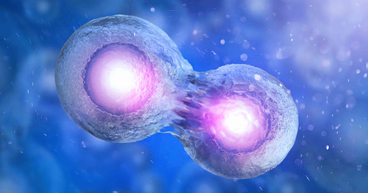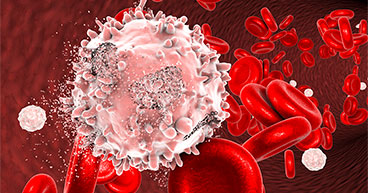
When cancer develops in the blood, it usually doesn’t form tumors. Instead, the damaged cells quickly multiply, crowd out healthy cells and overtake the bloodstream. When that happens, many oncologists will consider a bone marrow or stem cell transplant to replace the damaged blood cells with new ones.
Undergoing a bone marrow or stem cell transplant is like giving new life to the blood in patients diagnosed with a liquid cancer, such as leukemia, lymphoma and multiple myeloma. The stem cells, which may come from a family member, an unrelated donor, or even from yourself, are harvested and then later infused into the blood to help build back new blood cells and replace those that have been damaged or destroyed by cancer. Bone marrow or stem cell transplants may also be used to replace cells damaged by chemotherapy or radiation therapy and to treat other conditions and cancers, such as anemia, testicular cancer or some pediatric solid tumors. Transplants may also treat disorders of the blood and immune system, including sickle cell disease.
The Center for International Blood and Marrow Transplant Research reports that 22,729 hematopoietic stem cell transplantations were performed in the United States in 2018.
This article will explain bone marrow and stem cell transplants and donations, covering these topics:
- What are stem cells?
- How are stem cells collected?
- What’s the difference between types of transplants?
- What to expect when receiving a transplant?
- What is graft vs. host disease?
- Getting new vaccines
- Stem cell transplants at Cancer Treatment Centers of America® (CTCA)
- The Be the Match® program
If you’ve been diagnosed with a blood cancer, such as leukemia or lymphoma, and are interested in getting a second opinion on your diagnosis and treatment plan, call us or chat online with a member of our team.
What are stem cells?
Hematopoietic stem cells, which literally means “blood-generating” stem cells, are immature cells produced in bone marrow that then move into the bloodstream. They can develop into any type of blood cell the body needs.
Stem cells are capable of self-renewal, which means they can multiply by replicating and dividing themselves over time. The hematopoietic stem cells used in transplants are harvested from adults (either the patient or a donor) or are donated from the umbilical cord of newborns. Embryonic stem cells, which are found in the human embryo during an early stage of pregnancy, are not used in hematopoietic stem cell transplants.
How are stem cells collected?
The terms stem cell transplant and bone marrow transplant are often used interchangeably. But there’s a difference, and it lies in how the stem cells are collected.
Stem cell collection
The process for donating stem cells from peripheral blood—which flows though veins and arteries—is similar to giving blood. One big difference is that a stem cell donation may take up to five days, including the time it takes to conduct the necessary tests and medication injections required to build up the amount of stem cells in the donor’s blood.
In a stem cell transplant, peripheral blood is drawn from a vein and sent through a machine that separates the stem cells. The blood is then returned to the body. This process, which is called apheresis, may take up to five hours.
The risk of side effects from this procedure are very low, but may include tiredness, headaches and joint or bone pain.
Bone marrow harvesting
Harvesting stem cells from bone marrow—a spongy, blood-cell producing material found inside bones—is a much more invasive procedure.
In the operating room, doctors harvest the cells while the donor is under anesthesia, removing up to two pints (or 5 percent) of the donor’s bone marrow from a hip bone. The marrow is then filtered to remove solids, such as fats and bone fragments, before it’s ready to be infused.
After the procedure, the donor is taken to the recovery room and kept under observation before being released, often the same day.
Complications from a bone marrow donation are rare, but they may include pain or soreness at the injection site and a slight risk of infection.
What’s the difference in transplant types?
There are two basic types of transplants:
Autologous transplant: The stem cells are collected from the patient’s blood and frozen in liquid nitrogen until needed for the transplant.
Allogeneic transplant: The stem cells come from a donor who has been identified as a good match. Doctors are looking for a donor whose blood proteins, called human leukocyte antigens or HLA, are very similar to the patient’s.
When the stem cells are donated by an identical twin of the patient, it’s called a syngeneic transplant.
“There are many advantages with an autologous transplant,” says Jeffrey R. Schriber, MD, Director of Hematologic Malignancies at CTCA® Phoenix. “Everyone has a donor. It’s relatively simple. The costs are less and the toxicities are less. The disadvantage is, sometimes, they don’t work as well. Allogeneic transplants may be more effective but have more risks.”
Autologous transplants, using the patient’s own stem cells, may be performed for most types of multiple myeloma and some lymphomas, says Istvan Redei, MD, Director of Hematology and Bone Marrow Transplants at CTCA Chicago. Allogeneic transplants, using donated stem cells, may be required to treat leukemia, specific types of lymphoma and some cases of high-risk multiple myeloma, Dr. Redei says.
Transplant stem cells may also come from a cord blood donation, which is blood taken from the umbilical cord and placenta of a newborn. Parents have agreed to that donation prior to their child’s birth, and the cord blood is cryogenically preserved until a match is found and it’s needed for transplantation. These are not embryonic stem cells.
What to expect
After a blood cancer diagnosis, the first line of treatment for many patients is chemotherapy. Most of the time, before being considered for a stem cell transplant, the body needs to show some response to chemotherapy. Patients should talk to their doctor about all available treatments and whether or when a transplant may be an option.
When a transplant is performed through a peripheral blood collection, the patient or donor (for an autologous transplant) is first given an injection of a growth factor that increases the amount of stem cells in his or her blood. The growth factor is not needed when the stem cells are collected directly from the marrow, which has a higher concentration of stem cells.
After collection from the patient for an autologous transplant, the stem cells are cryogenically preserved. The patient returns a week later for what’s called conditioning, a regimen involving high doses of chemotherapy designed to eliminate stem cells in the marrow. The conditioning is usually performed during a series of outpatient hospital visits for up to a week.
If the transplant is allogeneic, the collection from the donor is typically performed at the same time as patient undergoes conditioning.
There are two types of preparative regimens:
- Myeloablative, where the chemotherapy dosage is very high, killing all the cells in the blood
- Non-myeloablative, which is a chemotherapy treatment that is less toxic, often used for older individuals who may not be able to withstand the stronger chemotherapy drugs
Once the blood’s cells have been eliminated through chemotherapy treatments, the patient will be admitted to the hospital and prepared for the process of receiving the replacement stem cells. The transplant is often performed through the same central line, or port, that is implanted in the chest and also was used to administer the chemotherapy. The stem cells flow into the blood, enter the marrow and eventually start producing new, healthy blood cells, a process called engraftment.
Until the stem cells engraft in the bone cavities, the bone marrow can’t produce its own blood cells. During this time, patents are at risk for anemia, bleeding or infection.
After an allogeneic transplant, the body may start attacking the new cells as foreign invaders—or the new cells may attack the body, identifying the cells and tissues as the foreign invaders. That’s why allogeneic transplant patients also receive immunosuppressive medications. These transplants are considered riskier than autologous transplants because of the need for the immunosuppressive drugs and the side effects they may leave patients more susceptible to infection.
While an autologous transplant patient is usually in the hospital for about two to three weeks, allogeneic transplant patients will typically have a longer stay, of about four weeks, to allow for additional observation to ensure the new stem cells are not causing complications.
Doctors closely monitor blood counts during the hospital stay under both transplant scenarios, watching for complications. The doctors will wait for the blood count to reach acceptable levels before releasing the patient from the hospital.
What is graft vs. host disease?
A serious complication that may develop in allogeneic transplants is graft vs. host disease (GVHD), when the donated stem cells attack the body, just like they’d attack a foreign invader. Dr. Redei says a mild case of GVHD may actually be a good thing, because the same condition that has it attacking your body’s cells would also lead it to attack and kill remaining cancer cells.
Acute GVHD may be treated with higher doses of immunosuppressive drugs. The Leukemia & Lymphoma Society says side effects of acute GVHD may include:
- A burning rash on the palms or the soles of the feet, possibly on the trunk or other extremities
- Nausea, vomiting, abdominal cramps, loss of appetite or diarrhea
- Jaundice (yellowing of the skin or eyes)
Side effects should be reported immediately to the treating physician.
Getting new vaccines
Cancer patients receiving stem cell transplants are immunocompromised, putting them at greater risk if they contract COVID-19 or another disease. Patients should follow guidelines established by the U.S. Centers for Disease Control and Prevention (CDC), including wearing a mask in public, socially distancing from others, frequently washing their hands and avoiding crowds and children. It may be six months or longer after a transplant before patients are ready to be vaccinated.
By wiping out all of the original blood cells, the high-dose chemotherapy that’s part of the preparatory regimen also eliminates childhood immunizations and other vaccines the patient previously received, such as the MMR vaccine for measles, mumps and rubella. Some immunizations can begin to be readministered about six months after the transplant. Patients may have to wait two years to begin receiving the MMR vaccine, because it contains a live virus that the immune system may not be able to handle until it’s much stronger. Patients should check with their doctor as to the timing of vaccinations.
There’s also another change that may take place. If the donor has a different blood type than the recipient, the recipient’s blood type will eventually change to be the same as the donor’s. That’s because the donated stem cells are now producing new red blood cells.
Stem cell transplants at CTCA
Our teams in CTCA Chicago and CTCA Phoenix handle both the collection of stem cells and transplantation. Our trained staff will help you through each process, whether you’ve been identified as a donor match or are in need of a stem cell transplant. At CTCA Phoenix, our experts perform only autologous transplants. The experts at CTCA Chicago conduct autologous and allogeneic transplants.
At CTCA, transplant patients, like all CTCA patients, receive personalized, comprehensive care from a team of multidisciplinary experts, with a treatment plan tailored to their individual needs. CTCA doctors will also work with your hometown doctor to collect necessary documents and medical records before transplant, and with transitioning you back to your hometown doctor after the transplant, says Roy Thomas, Director of Operations for Hematology and Bone marrow transplant for CTCA.
The hematologic oncology care teams at CTCA include oncologists with specific training in hematologic malignancies, as well as a nurse care manager and transplant coordinator. To help you manage potential side effects of the transplant and preparation regimen, your care team may also include an oncology-trained dietitian, naturopathic support provider and/or behavioral health provider.
Be the Match
Unrelated donor matches for transplants performed at CTCA Chicago are coordinated through the National Marrow Donor Program, called Be The Match, with the donated stem cells delivered by courier to the hospital.
When the donor is a relative, CTCA will perform the eligibility testing that’s needed to make sure the family member is a good match. If the relative’s or the patient’s own stem cells are not deemed to be suitable, stem cells will need to be donated from someone unrelated to the patient.
CTCA Chicago is also a collection center for the National Marrow Donor Program, coordinating donors from across the Midwest, including those donating for patients being treated at other medical facilities. The program arranges lodging for donors during the collection process, which usually takes about five days, including the time it takes to receive a growth factor, to enhance the donor’s production of blood stem cells and to collect the stem cells.
The National Marrow Donor Program invites donations from adults ages 18 to 44, although some donations are allowed until age 60. Research shows that cells from younger donors lead to more successful transplants, the registry says.
If you volunteer to participate in the Be the Match Registry, you won’t make a stem cell donation until you’re identified as a match for someone needing a transplant.
If you’ve been diagnosed with a blood cancer, such as leukemia or lymphoma, and are interested in getting a second opinion on your diagnosis and treatment plan, call us or chat online with a member of our team.



